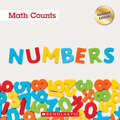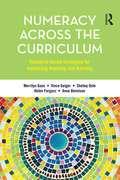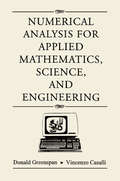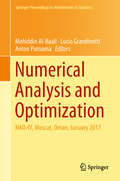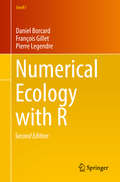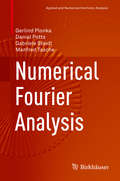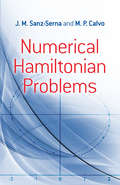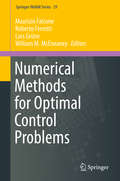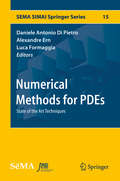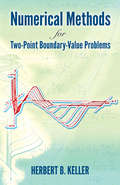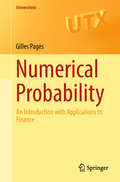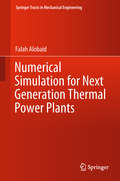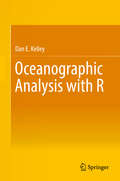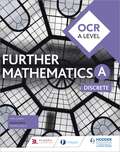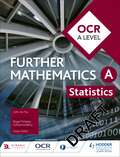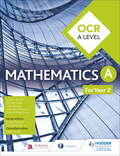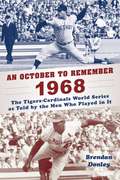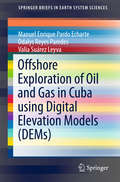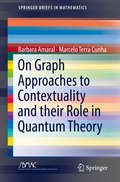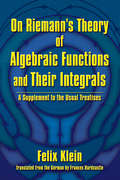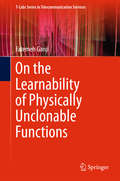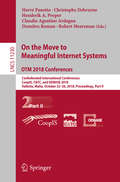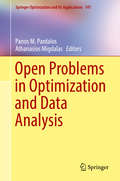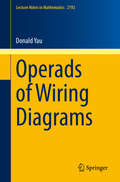- Table View
- List View
Numbers (Math Counts: Updated Editions)
by Henry PluckroseAn introduction to capacity for the youngest readers!Math Counts series introduces young readers (grades K-3) to early math concepts. Real-world examples and corresponding photos make math concepts easy to grasp.Numbers help us in many ways by giving us all types of information-from a person's addresses to the size of a dress and more.
Numeracy Across the Curriculum: Research-based strategies for enhancing teaching and learning
by Merrilyn Goos Vince Geiger Helen Forgasz Anne Bennison Shelley DoleBeing numerate involves more than mastering basic mathematics. Numeracy connects the mathematics learned at school with out-of-school situations that require capabilities such as problem solving, critical judgment, and sense-making related to non-mathematical contexts. This book provides prospective and practising teachers with practical, research-based strategies for embedding numeracy across the primary and secondary school curriculum. Based on the authors' ten-year research program, the text explains what numeracy is and how numeracy has developed as an educational goal. It describes in detail the five dimensions of the authors' model: attention to real-life contexts; application of mathematical knowledge; use of physical, representational and digital tools; the promotion of positive dispositions towards the use of mathematics to solve problems encountered in day-to-day life; and a critical orientation to interpreting mathematical results and making evidence-based judgements. There is guidance on how to embed numeracy across all subjects within the curriculum, how to assess numeracy learning and how to deal with challenges and dilemmas including working with discipline boundaries and developing support resources.Featuring practical examples and case studies throughout, this book will build pre-service teacher confidence, demystify common misconceptions and grounds theory into practice in this vital area of student competency.'The authors of this text are recognised authorities on numeracy. They have engaged heavily in numeracy research over many years and this text reflects the depth of their understanding and knowledge.' - Geoff Hilton, University of Queensland
Numerical Analysis
by Donald GreenspanFirst Published in 2018. Routledge is an imprint of Taylor & Francis, an Informa company.
Numerical Analysis and Optimization: Nao-iii, Muscat, Oman, January 2014 (Springer Proceedings in Mathematics & Statistics #134)
by Mehiddin Al-Baali Lucio Grandinetti Anton PurnamaThis volume contains 13 selected keynote papers presented at the Fourth International Conference on Numerical Analysis and Optimization. Held every three years at Sultan Qaboos University in Muscat, Oman, this conference highlights novel and advanced applications of recent research in numerical analysis and optimization. Each peer-reviewed chapter featured in this book reports on developments in key fields, such as numerical analysis, numerical optimization, numerical linear algebra, numerical differential equations, optimal control, approximation theory, applied mathematics, derivative-free optimization methods, programming models, and challenging applications that frequently arise in statistics, econometrics, finance, physics, medicine, biology, engineering and industry. Any graduate student or researched wishing to know the latest research in the field will be interested in this volume. This book is dedicated to the late Professors Mike JD Powell and Roger Fletcher, who were the pioneers and leading figures in the mathematics of nonlinear optimization.
Numerical Ecology with R (Use R!)
by Daniel Borcard François Gillet Pierre LegendreThis new edition of Numerical Ecology with R guides readers through an applied exploration of the major methods of multivariate data analysis, as seen through the eyes of three ecologists. It provides a bridge between a textbook of numerical ecology and the implementation of this discipline in the R language. The book begins by examining some exploratory approaches. It proceeds logically with the construction of the key building blocks of most methods, i.e. association measures and matrices, and then submits example data to three families of approaches: clustering, ordination and canonical ordination. The last two chapters make use of these methods to explore important and contemporary issues in ecology: the analysis of spatial structures and of community diversity. The aims of methods thus range from descriptive to explanatory and predictive and encompass a wide variety of approaches that should provide readers with an extensive toolbox that can address a wide palette of questions arising in contemporary multivariate ecological analysis. The second edition of this book features a complete revision to the R code and offers improved procedures and more diverse applications of the major methods. It also highlights important changes in the methods and expands upon topics such as multiple correspondence analysis, principal response curves and co-correspondence analysis. New features include the study of relationships between species traits and the environment, and community diversity analysis. This book is aimed at professional researchers, practitioners, graduate students and teachers in ecology, environmental science and engineering, and in related fields such as oceanography, molecular ecology, agriculture and soil science, who already have a background in general and multivariate statistics and wish to apply this knowledge to their data using the R language, as well as people willing to accompany their disciplinary learning with practical applications. People from other fields (e.g. geology, geography, paleoecology, phylogenetics, anthropology, the social and education sciences, etc.) may also benefit from the materials presented in this book. Users are invited to use this book as a teaching companion at the computer. All the necessary data files, the scripts used in the chapters, as well as extra R functions and packages written by the authors of the book, are available online (URL: http://adn.biol.umontreal.ca/~numericalecology/numecolR/).
Numerical Fourier Analysis (Applied and Numerical Harmonic Analysis)
by Gerlind Plonka Daniel Potts Gabriele Steidl Manfred TascheThis book offers a unified presentation of Fourier theory and corresponding algorithms emerging from new developments in function approximation using Fourier methods. It starts with a detailed discussion of classical Fourier theory to enable readers to grasp the construction and analysis of advanced fast Fourier algorithms introduced in the second part, such as nonequispaced and sparse FFTs in higher dimensions. Lastly, it contains a selection of numerical applications, including recent research results on nonlinear function approximation by exponential sums. The code of most of the presented algorithms is available in the authors’ public domain software packages. Students and researchers alike benefit from this unified presentation of Fourier theory and corresponding algorithms.
Numerical Hamiltonian Problems (Dover Books on Mathematics)
by J.M. Sanz-Serna M. P. CalvoThis advanced text explores a category of mathematical problems that occur frequently in physics and other sciences. Five preliminary chapters make the book accessible to students without extensive background in this area. Topics include Hamiltonian systems, symplecticness, numerical methods, order conditions, and implementation.The heart of the book, chapters 6 through 10, explores symplectic integration, symplectic order conditions, available symplectic methods, numerical experiments, and properties of symplectic integrators. The final four chapters contain more advanced material: generating functions, Lie formalism, high-order methods, and extensions. Many numerical examples appear throughout the text.
Numerical Methods for Optimal Control Problems (Springer INdAM Series #29)
by Maurizio Falcone Roberto Ferretti Lars Grüne William M. McEneaneyThis work presents recent mathematical methods in the area of optimal control with a particular emphasis on the computational aspects and applications. Optimal control theory concerns the determination of control strategies for complex dynamical systems, in order to optimize some measure of their performance. Started in the 60's under the pressure of the "space race" between the US and the former USSR, the field now has a far wider scope, and embraces a variety of areas ranging from process control to traffic flow optimization, renewable resources exploitation and management of financial markets. These emerging applications require more and more efficient numerical methods for their solution, a very difficult task due the huge number of variables. The chapters of this volume give an up-to-date presentation of several recent methods in this area including fast dynamic programming algorithms, model predictive control and max-plus techniques. This book is addressed to researchers, graduate students and applied scientists working in the area of control problems, differential games and their applications.
Numerical Methods for PDEs: State of the Art Techniques (SEMA SIMAI Springer Series #15)
by Daniele Antonio Di Pietro Alexandre Ern Luca FormaggiaThis volume gathers contributions from participants of the Introductory School and the IHP thematic quarter on Numerical Methods for PDE, held in 2016 in Cargese (Corsica) and Paris, providing an opportunity to disseminate the latest results and envisage fresh challenges in traditional and new application fields. Numerical analysis applied to the approximate solution of PDEs is a key discipline in applied mathematics, and over the last few years, several new paradigms have appeared, leading to entire new families of discretization methods and solution algorithms. This book is intended for researchers in the field.
Numerical Methods for Two-Point Boundary-Value Problems (Dover Books on Mathematics)
by Herbert B. KellerA concise, elementary yet rigorous account of practical numerical methods for solving very general two-point boundary-value problems. Directed to students with a knowledge of advanced calculus and basic numerical analysis, and some background in ordinary differential equations and linear algebra. More than 100 problems augment and clarify the textual material. 1968 edition.
Numerical Probability: An Introduction with Applications to Finance (Universitext)
by Gilles PagèsThis textbook provides a self-contained introduction to numerical methods in probability with a focus on applications to finance. Topics covered include the Monte Carlo simulation (including simulation of random variables, variance reduction, quasi-Monte Carlo simulation, and more recent developments such as the multilevel paradigm), stochastic optimization and approximation, discretization schemes of stochastic differential equations, as well as optimal quantization methods. The author further presents detailed applications to numerical aspects of pricing and hedging of financial derivatives, risk measures (such as value-at-risk and conditional value-at-risk), implicitation of parameters, and calibration. Aimed at graduate students and advanced undergraduate students, this book contains useful examples and over 150 exercises, making it suitable for self-study.
Numerical Simulation for Next Generation Thermal Power Plants (Springer Tracts in Mechanical Engineering)
by Falah AlobaidThe book provides highly specialized researchers and practitioners with a major contribution to mathematical models’ developments for energy systems. First, dynamic process simulation models based on mixture flow and two-fluid models are developed for combined-cycle power plants, pulverised coal-fired power plants, concentrated solar power plant and municipal waste incineration. Operation data, obtained from different power stations, are used to investigate the capability of dynamic models to predict the behaviour of real processes and to analyse the influence of modeling assumptions on simulation results. Then, a computational fluid dynamics (CFD) simulation programme, so-called DEMEST, is developed. Here, the fluid-solid, particle-particle and particle-wall interactions are modeled by tracking all individual particles. To this purpose, the deterministic Euler-Lagrange/Discrete Element Method (DEM) is applied and further improved. An emphasis is given to the determination of inter-phase values, such as volumetric void fraction, momentum and heat transfers, using a new procedure known as the offset-method and to the particle-grid method allowing the refinement of the grid resolution independently from particle size. Model validation is described in detail. Moreover, thermochemical reaction models for solid fuel combustion are developed based on quasi-single-phase, two-fluid and Euler-Lagrange/MP-PIC models. Measurements obtained from actual power plants are used for validation and comparison of the developed numerical models.
Numerical Solution of Differential Equations: Introduction to Finite Difference and Finite Element Methods
by Zhilin Li Zhonghua Qiao Tao TangThis introduction to finite difference and finite element methods is aimed at graduate students who need to solve differential equations. The prerequisites are few (basic calculus, linear algebra, and ODEs) and so the book will be accessible and useful to readers from a range of disciplines across science and engineering. Part I begins with finite difference methods. Finite element methods are then introduced in Part II. In each part, the authors begin with a comprehensive discussion of one-dimensional problems, before proceeding to consider two or higher dimensions. An emphasis is placed on numerical algorithms, related mathematical theory, and essential details in the implementation, while some useful packages are also introduced. The authors also provide well-tested MATLAB codes, all available online.
Oceanographic Analysis with R
by Dan E. KelleyThis book presents the R software environment as a key tool for oceanographic computations and provides a rationale for using R over the more widely-used tools of the field such as MATLAB. Kelley provides a general introduction to R before introducing the ‘oce’ package. This package greatly simplifies oceanographic analysis by handling the details of discipline-specific file formats, calculations, and plots. Designed for real-world application and developed with open-source protocols, oce supports a broad range of practical work. Generic functions take care of general operations such as subsetting and plotting data, while specialized functions address more specific tasks such as tidal decomposition, hydrographic analysis, and ADCP coordinate transformation. In addition, the package makes it easy to document work, because its functions automatically update processing logs stored within its data objects. Kelley teaches key R functions using classic examples from the history of oceanography, specifically the work of Alfred Redfield, Gordon Riley, J. Tuzo Wilson, and Walter Munk. Acknowledging the pervasive popularity of MATLAB, the book provides advice to users who would like to switch to R. Including a suite of real-life applications and over 100 exercises and solutions, the treatment is ideal for oceanographers, technicians, and students who want to add R to their list of tools for oceanographic analysis.
OCR A Level Further Mathematics Discrete
by Nick GeereStudent eTextbooks are downloadable versions of the printed textbook, purchased on a copy-by-copy basis and allocated to students through Dynamic Learning. Our Student eTextbooks link seamlessly with MEI Integral Further Mathematics online resources, allowing you to move with ease between corresponding topics in the eTextbooks and Integral.Integral has been developed by MEI and supports teachers and students with high quality teaching and learning activities, including dynamic resources and self-marking tests and assessments that cover the new specifications.To have full access to the eTextbooks and Integral resources you must be subscribed to both Dynamic Learning and Integral. To subscribe to Integral, visit www.integralmaths.org. For more information on our eTextbooks and Integral please see the Quick Links box.Provide full support for the OCR Discrete content of the new specification with worked examples, stimulating activities and assessment support to help develop understanding, reasoning and problem solving. - Help prepare students for assessment with skills-building activities and fully worked examples and solutions tailored to the changed criteria.- Build understanding through carefully worded expositions that set out the basics and the detail of each topic, with call-outs to add clarity.- Test knowledge and develop understanding, reasoning and problem solving with banded Exercise questions that increase in difficulty (answers provided in the back of the book and online). - Gain a full understanding of the logical steps that are used in creating each individual algorithm - Encourages students to track their progress using learning outcomes and Key Points listed at the end of each chapter.
OCR A Level Further Mathematics Statistics
by John du FeuAchieve your full potential with learning materials that guide you through the Statistics content of the new AS and A-level Further Maths specifications; developed by subject experts and in conjunction with MEI (Mathematics in Education and Industry).- Ensure targeted development of reasoning and problem-solving skills with plenty of practice questions and structured exercises that build statistical skills and techniques.- Identify connections between topics, with real-world contexts to help develop modelling skills, thus providing a fuller and more coherent understanding of statistical concepts.- Address the new statistics requirements with questions around the use of large data sets. - Cover the use of technology in mathematics with a variety of questions based around the use of spreadsheets, graphing software and graphical calculators. - Overcome misconceptions and develop insight into problem solving with annotated worked examples.
OCR A Level Mathematics Year 2
by Sophie Goldie Susan Whitehouse Val Hanrahan Cath Moore Jean-Paul MuscatBoost your students' knowledge, skills and understanding so that they can reason and apply mathematical techniques in solving problems; with resources developed specifically for the OCR specification by subject experts and in conjunction with MEI (Mathematics in Education and Industry).- Boosts students' confidence approaching assessment with plenty of practice questions and skill-focused exercises.- Build connections between topics with points of interest and things to notice such as links to real world examples and noticing patterns in the mathematics. - Ensure targeted development of problem-solving, proof and modelling with dedicated sections on these key areas.- Help students to overcome misconceptions and develop insight into problem-solving with annotated worked examples.- Enhance individual understanding with discussion points designed for the classroom and end of chapter summaries of the key points.- Tackle the new statistics requirements with five dedicated statistics chapters and questions around the use of large data sets. - Address the use of technology in Mathematics with a variety of questions based around the use of spreadsheets, graphing software and graphing calculators. - Provide clear paths of progression that combine pure and applied maths into a coherent whole.- Reinforce Year 1 content with short review chapters - Year 2 only
An October to Remember 1968: The Tigers-Cardinals World Series as Told by the Men Who Played in It
by Brendan DonleyAn October to Remember 1968: The Tigers-Cardinals World Series as Told by the Men Who Played in It recalls one of baseball's most celebrated championship series from the voices of the players who still remain--a collected narrative from a bygone era of major-league baseball as they reflect fifty years later.Modeled after Lawrence S. Ritter's celebrated book, The Glory of Their Times--for which the author traversed the country to record stories of baseball's deadball era--An October to Remember 1968 will likewise preserve the days of baseball past, gathering the memories of the remaining players of the great Tigers and Cardinals teams to assemble their accounts into a vibrant baseball collection. The 1968 World Series came at a time of great cultural change--the fading days of fans dressing up for ballgames, the first years of widespread color TV--and was an historic matchup of two legendary teams, pitting star power head-to-head and going the distance of seven hard-fought games. From the voices of the players themselves, An October to Remember 1968 illustrates in detail what it was like to be a 1968 Tiger, a 1968 Cardinal: what it was like to win it all and to lose it all: what it was like to face Bob Gibson peering in from the mound, Al Kaline digging in at the plate; what it was like, in the player's own words, to remember the days of that most special period in the history of America's national pastime.
Offshore Exploration of Oil and Gas in Cuba using Digital Elevation Models (SpringerBriefs in Earth System Sciences)
by Valia Suárez Leyva Odalys Reyes Paredes Manuel Enrique Pardo EcharteThis book provides an overview of the major changes induced by hydrocarbons (HCs) affecting rocks and surface sediments and their implications for non-seismic exploration methods, particularly for marine territories near Cuba. It examines the use of a digital elevation model (DEM) at 90x90m resolution for the detection of subtle, positive geomorphic anomalies related to hydrocarbon microseepage (vertical migration) on possible oil and gas targets. The results support the conclusion that the DEM data provides a low cost and fast offshore oil and gas preliminary exploration strategy. This data is useful serving to focus prospective areas with supplementary unconventional methods such as magnetic-induced polarization (MIP), useful to propose more expensive volumes for detailed 2D–3D seismic surveys.
On Graph Approaches to Contextuality and their Role in Quantum Theory (SpringerBriefs in Mathematics)
by Barbara Amaral Marcelo Terra CunhaThis book explores two of the most striking features of quantum theory – contextuality and nonlocality – using a formulation based on graph theory. Quantum theory provides a set of rules to predict probabilities of different outcomes in different experimental settings, and both contextuality and nonlocality play a fundamental role in interpreting the outcomes. In this work, the authors highlight how the graph approach can lead to a better understanding of this theory and its applications. After presenting basic definitions and explaining the non-contextuality hypothesis, the book describes contextuality scenarios using compatibility hypergraphs. It then introduces the exclusivity graph approach, which relates a number of important graph-theoretical concepts to contextuality. It also presents open problems such as the so-called Exclusivity Principle, as well as a selection of important topics, like sheaf-theoretical approach, hypergraph approach, and alternative proofs of contextuality.
On Riemann's Theory of Algebraic Functions and Their Integrals: A Supplement to the Usual Treatises (Dover Books on Mathematics)
by Felix KleinA great researcher, writer, and teacher in an era of tremendous mathematical ferment, Felix Klein (1849–1925) occupies a prominent place in the history of mathematics. His many talents included an ability to express complicated mathematical ideas directly and comprehensively, and this book, a consideration of the investigations in the first part of Riemann's Theory of Abelian Functions, is a prime example of his expository powers.
On the Learnability of Physically Unclonable Functions (T-Labs Series in Telecommunication Services)
by Fatemeh GanjiThis book addresses the issue of Machine Learning (ML) attacks on Integrated Circuits through Physical Unclonable Functions (PUFs). It provides the mathematical proofs of the vulnerability of various PUF families, including Arbiter, XOR Arbiter, ring-oscillator, and bistable ring PUFs, to ML attacks. To achieve this goal, it develops a generic framework for the assessment of these PUFs based on two main approaches. First, with regard to the inherent physical characteristics, it establishes fit-for-purpose mathematical representations of the PUFs mentioned above, which adequately reflect the physical behavior of these primitives. To this end, notions and formalizations that are already familiar to the ML theory world are reintroduced in order to give a better understanding of why, how, and to what extent ML attacks against PUFs can be feasible in practice. Second, the book explores polynomial time ML algorithms, which can learn the PUFs under the appropriate representation. More importantly, in contrast to previous ML approaches, the framework presented here ensures not only the accuracy of the model mimicking the behavior of the PUF, but also the delivery of such a model. Besides off-the-shelf ML algorithms, the book applies a set of algorithms hailing from the field of property testing, which can help to evaluate the security of PUFs. They serve as a “toolbox”, from which PUF designers and manufacturers can choose the indicators most relevant for their requirements. Last but not least, on the basis of learning theory concepts, the book explicitly states that the PUF families cannot be considered as an ultimate solution to the problem of insecure ICs. As such, it provides essential insights into both academic research on and the design and manufacturing of PUFs.
On the Move to Meaningful Internet Systems. OTM 2018 Conferences: Confederated International Conferences: CoopIS, C&TC, and ODBASE 2018, Valletta, Malta, October 22-26, 2018, Proceedings, Part II (Lecture Notes in Computer Science #11230)
by Hervé Panetto Christophe Debruyne Henderik A. Proper Claudio Agostino Ardagna Dumitru Roman Robert MeersmanThis double volumes LNCS 11229-11230 constitutes the refereed proceedings of the Confederated International Conferences: Cooperative Information Systems, CoopIS 2018, Ontologies, Databases, and Applications of Semantics, ODBASE 2018, and Cloud and Trusted Computing, C&TC, held as part of OTM 2018 in October 2018 in Valletta, Malta. The 64 full papers presented together with 22 short papers were carefully reviewed and selected from 173 submissions. The OTM program every year covers data and Web semantics, distributed objects, Web services, databases, informationsystems, enterprise workflow and collaboration, ubiquity, interoperability, mobility, grid and high-performance computing.
Open Problems in Optimization and Data Analysis (Springer Optimization and Its Applications #141)
by Panos M. Pardalos Athanasios MigdalasComputational and theoretical open problems in optimization, computational geometry, data science, logistics, statistics, supply chain modeling, and data analysis are examined in this book. Each contribution provides the fundamentals needed to fully comprehend the impact of individual problems. Current theoretical, algorithmic, and practical methods used to circumvent each problem are provided to stimulate a new effort towards innovative and efficient solutions. Aimed towards graduate students and researchers in mathematics, optimization, operations research, quantitative logistics, data analysis, and statistics, this book provides a broad comprehensive approach to understanding the significance of specific challenging or open problems within each discipline. The contributions contained in this book are based on lectures focused on “Challenges and Open Problems in Optimization and Data Science” presented at the Deucalion Summer Institute for Advanced Studies in Optimization, Mathematics, and Data Science in August 2016.
Operads of Wiring Diagrams (Lecture Notes in Mathematics #2192)
by Donald YauWiring diagrams form a kind of graphical language that describes operations or processes with multiple inputs and outputs, and shows how such operations are wired together to form a larger and more complex operation. This monograph presents a comprehensive study of the combinatorial structure of the various operads of wiring diagrams, their algebras, and the relationships between these operads.The book proves finite presentation theorems for operads of wiring diagrams as well as their algebras. These theorems describe the operad in terms of just a few operadic generators and a small number of generating relations. The author further explores recent trends in the application of operad theory to wiring diagrams and related structures, including finite presentations for the propagator algebra, the algebra of discrete systems, the algebra of open dynamical systems, and the relational algebra. A partial verification of David Spivak’s conjecture regarding the quotient-freeness of the relational algebra is also provided. In the final part, the author constructs operad maps between the various operads of wiring diagrams and identifies their images. Assuming only basic knowledge of algebra, combinatorics, and set theory, this book is aimed at advanced undergraduate and graduate students as well as researchers working in operad theory and its applications. Numerous illustrations, examples, and practice exercises are included, making this a self-contained volume suitable for self-study.
